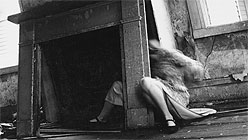An extensive exhibition of vintage photographic prints, along with rarely seen artist books and video, from the short but prolific career of Francesca Woodman opened this month at the San Francisco Museum of Modern Art. The 174 works on view regularly feature Woodman experimenting with the placement of her own often nude form in contrast with the crumbling interiors of abandoned buildings. Spare and elegant, these black and white images sometimes read like lost illustrations from early feminist Charlotte Perkins Gilman’s 19th century short story, “The Yellow Wallpaper,” with Woodman appearing to blend at times with the architecture.
One series from Woodman’s years as an undergraduate at the Rhode Island School of Design was shot in an abandoned house in Providence; the House series (1975 – 77) depicts the artist’s form blurring with the architecture through simple effects. Further works were developed in Rome while studying in the RISD Rome Honors Program, following her graduation while living in New York, and later as a fellow at the MacDowell Colony in Peterborough, New Hampshire. Some thirty years after her death, Woodman’s experiments can be regarded as astonishingly prescient, anticipating the prevalence of photography and, to some extent, contemporary media’s capacity for self-reflection.

Francesca Woodman, House #4, Providence, Rhode Island, 1976; c. George and Betty Woodman.
The exhibition focuses on works from 1975-1981, leading up to the artist’s death by suicide at age 22. The challenge, among women artists in particular, is to separate the artist’s personal trials from considerations of the work. Within academia the work is resolutely regarded for its formal qualities and there has been extensive, if not excessive, intellectual discourse around the various critical implications of the work initiated by this young artist. Within the catalogue, exhibition curator and SFMOMA assistant curator of photography Corey Keller contends with the tremendous amount of posthumus critical attention focused on Woodman’s photographs over the last three decades and notes, “At times, the critical apparatus around them threatens to swamp the entire fragile enterprise.” Just as a preoccupation with her death would undermine the potency of Woodman’s work, so too does the prevailing tendency towards over analysis by intelligentsia.

Francesca Woodman, Caryatid, New York, 1980; c. George and Betty Woodman



